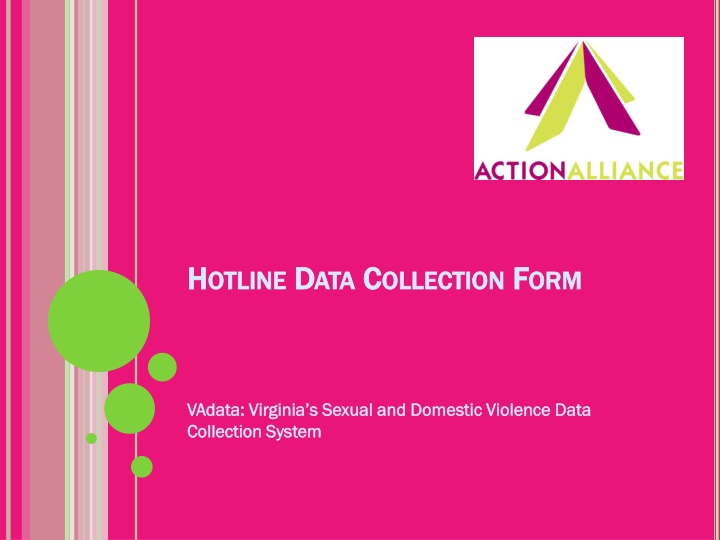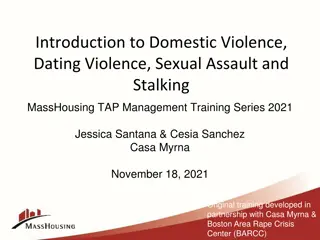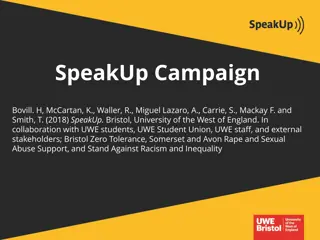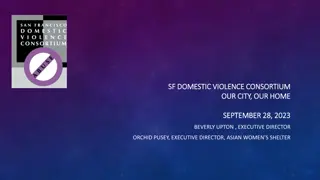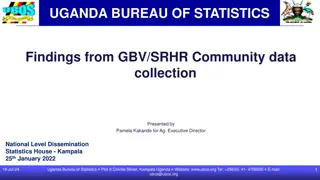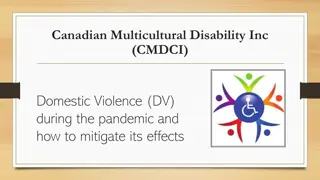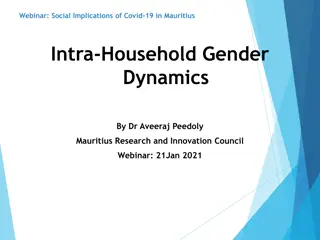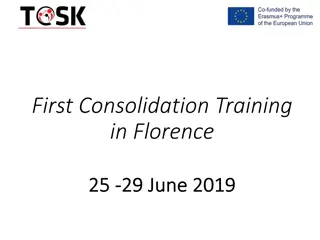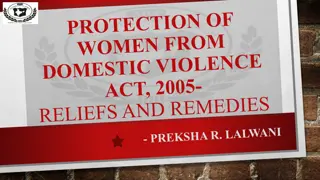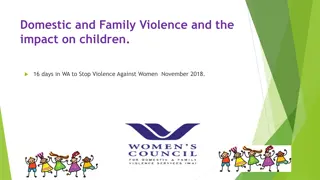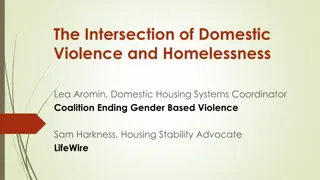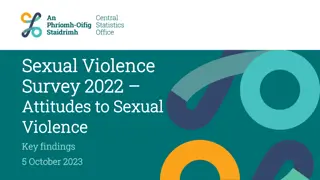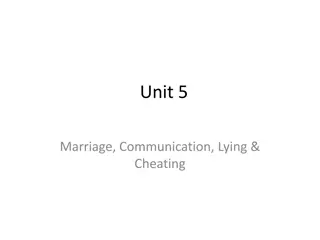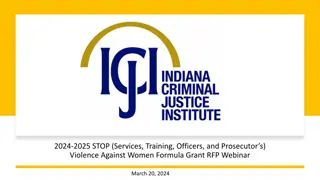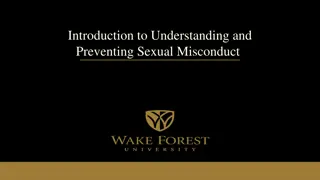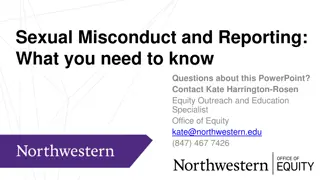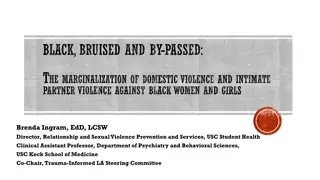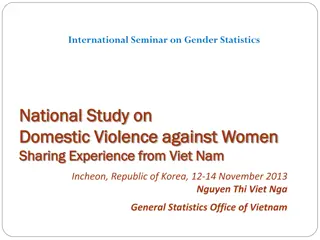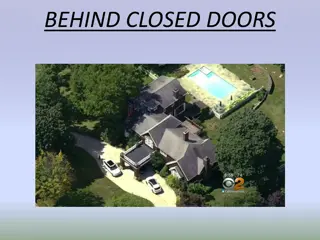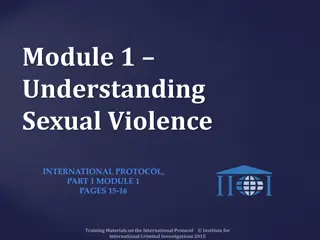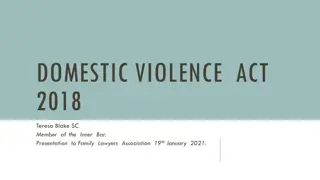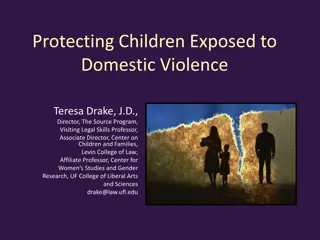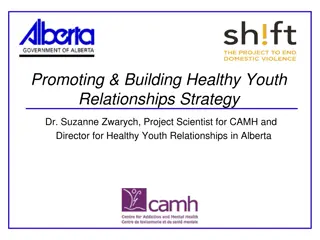Sexual and Domestic Violence Data Collection System
Virginia's Sexual and Domestic Violence Data Collection System captures hotline contacts, services provided, communication methods used, and information collected on forms to aid victim support and track agency efforts in addressing sexual and domestic violence cases.
Download Presentation

Please find below an Image/Link to download the presentation.
The content on the website is provided AS IS for your information and personal use only. It may not be sold, licensed, or shared on other websites without obtaining consent from the author.If you encounter any issues during the download, it is possible that the publisher has removed the file from their server.
You are allowed to download the files provided on this website for personal or commercial use, subject to the condition that they are used lawfully. All files are the property of their respective owners.
The content on the website is provided AS IS for your information and personal use only. It may not be sold, licensed, or shared on other websites without obtaining consent from the author.
E N D
Presentation Transcript
H HOTLINE OTLINE D DATA ATA C COLLECTION OLLECTION F FORM ORM VAdata VAdata: Virginia s Sexual and Domestic Violence Data : Virginia s Sexual and Domestic Violence Data Collection System Collection System
W WHAT HAT IS IS A A H HOTLINE OTLINE C CONTACT ONTACT? ? A hotline contact is any contact where you provide crisis/support services to a victim, family/friend of victim, parent/guardian of victim, or perpetrator. You should use the hotline form for all crisis service contacts, even those you may receive via your general office phone line.
WHAT IS A HOTLINE CALL? Sometimes a hotline call isn t an actual call . Many agencies have hotline services to communicate via text chat chat, and email email. If you are utilizing one of these methods of communication to provide hotline services, you can record how you communicated with the person (referred to as the caller ) using the Services Provided Via Services Provided Via drop-down list. This information is not required but will provide your agency with a means to track your methods of communication. text,
WHAT IS A HOTLINE CALL? Sometimes a person who is not the victim may contact you about your services. You must complete the demographics sections based on the person you are communicating with, who may not be the person you are communicating with, who may not be the victim victim In the Presenting Sexual or Domestic Violence sections, the Description of Person Receiving Services is the person you are directly communicating with. For the Type of Violence Experienced , this asks about what happened to the victim. based on the
INFORMATION COLLECTED ON THE HOTLINE FORM Contact s Demographics Information on Presenting Sexual and/or Domestic Violence Relationship of Contact to Victim (as you may not be working directly with the victim) Type of Sexual and/or Domestic Violence Experienced Perpetrator Information Information on Other Presenting Experience (any violence or other incident the victim may have experienced that isn t a sexual or domestic violence experience, yet is relevant to the services provided by your agency)
INFORMATION COLLECTED (CONT.) Risk Assessment Services and Referrals Provided Number of Contacts Made and Length of Hotline Contact Funding Source of Service Contact
WHY WE COLLECT WHAT WE DO Demographics To show that sexual and domestic violence affect people of different ages, races, genders, etc. Information such as age, race, disability status, etc. may influence or inform service delivery Presenting Sexual and Domestic Violence Experience Allows specific information to be collected about experiences of sexual and/or domestic violence Information on Other Presenting Experience Allows information to be collected about other experiences that a victim may have encountered that were not sexual or domestic violence related (but were relevant to the services provided by your agency)
WHY WE COLLECT WHAT WE DO Risk Assessment We include this on the hotline form because it is a reminder of potential safety risks with sexual and/or domestic violence We also hope that this aids in risk assessment and safety planning for all hotline contacts Services and Referrals Captures the remarkable work you do and connections you make on behalf of survivors Funding Source of Service Contact We collect this information to make sure that services are being counted in the appropriate reports
INFORMATION REQUIRED TO SUBMIT FORM For all hotline contacts, the following fields are required: Date Staff Name Gender Race/Ethnicity (you can select Other/Unknown ) Approximate Age (you can estimate. What is most important is the distinction between a child (0-17), an adult (18-59), and an older adult (60+)) Approximate Age of the Victim at the Time of Earliest Victimization (you can estimate) Locality of Residency (you can select Unknown ) Referral Source (you can select Unknown ) A Presenting Experience (Sexual or Domestic Violence, or Other Presenting Experience) At least one service under the Services Provided section Length of engagement Funding source (at least one must be selected)
INFORMATION REQUIRED (CONT.) For hotline contacts with a presenting sexual and/or domestic violence experience, the following fields are required: Relationship of Caller to Victim Type of Sexual and/or Domestic Violence Relationship of Perpetrator to Victim (you can select Unknown ) Please note: Please note: All other perpetrator information is optional should only be included if known. optional and
INFORMATION REQUIRED (CONT.) For each hotline contact, you must select at least one funding source, and you may select as many as apply. Service Contact Funded By Service Contact Funded By can be found at the bottom of the Hotline Form. at least one Advocates completing this form will need to consult with agency Directors to determine what types of contacts are funded by which source(s). NOTE NOTE: Only those designated DCJS-VSGP and meet the criteria will appear in the DCJS Sexual Assault Domestic Violence Grant Program report.
IMPORTANT NOTE: On the Hotline Form, you will see the following: Please respond to these questions for ALL request emergency housing/shelter (including those who may be from out of your area or who may not be in imminent danger). ALL survivors who It is crucial that we document when survivors are seeking shelter and shelters are full.
PRIMARY AND SECONDARY AGENCY This field was added specifically to allow the Virginia Statewide Hotline to track calls during periods when an agency has its lines forwarded. For most agencies, this feature is currently turned off. This feature can, however, be useful for agencies that take hotline calls on behalf of other agencies (such as regional hotlines) and would like to have a way to distinguish those calls. Contact the VAdata staff for details on how to utilize this feature. This is NOT a required field and will not be useful to all agencies (i.e. agencies that answer their own hotline 100% of the time).
QUESTIONS ABOUT THE HOTLINE FORM What about contacts from allied professionals about a specific victim? If the allied professional is seeking general information, then please complete a Community Engagement form Community Engagement form. If they are addressing a specific victim or family, then proceed with a Hotline form Hotline form. If you choose to report contacts from allied professionals on the Hotline form, remember you will need to complete the demographics section using the allied professional s demographic information, not the victim s.
QUESTIONS (CONT.) Do we fill out a form for crisis contacts that are not related to a sexual and/or domestic violence situation? Yes Yes. There are places on the form to indicate that it is not a sexual and/or domestic violence related contact.
QUESTIONS (CONT.) Do we fill out a form for crisis contacts that are not related to a sexual and/or domestic violence situation? (con t) For calls not related to a sexual or domestic violence issue, you can indicate the type of experience in the Other Presenting Experience section of the form. Check as many as apply, including No Violence Experienced
QUESTIONS (CONT.) Why are we collecting Approximate Age at the time of Earliest Victimization ? The field Approximate Age of the Victim at Earliest victimization Approximate Age of the Victim at Earliest victimization is a REQUIRED field, added to the Hotline Form in 2016. This field was added because DCJS required the collection of this information. The form only requires ONE ONE approximate age (if the caller had multiple victimizations at different ages, you will need to determine the person s age at the time of the very first victimization very first victimization even if the same victimization type occurred multiple times, different victimization types occurred over time, and/or the person did not disclose the victimization(s) until years after).
QUESTIONS (CONT.) If an allied professional, friend, or family member contacts us, do we still have to enter the Approximate Age of the Victim at Earliest Victimization ? Yes Yes. The field Approximate Age of the Victim at Approximate Age of the Victim at Earliest Victimization Earliest Victimization is a REQUIRED field. Demographic information (like gender, approximate age, race/ethnicity, etc.) should still be collected about the person who has contacted you (the allied professional, friend, or family member) and advocates should estimate the Approximate Age of the Victim at Earliest Victimization the Victim at Earliest Victimization for the person they have contacted your agency on behalf of. Approximate Age of
QUESTIONS (CONT.) What about other contacts received on the hotline, such as requests for general information on services, hours of operation, materials, donations, etc.? Your agency may be required to document these types of contacts for grant or other purposes. Record them on the Community Engagement form Community Engagement form.
QUESTIONS (CONT.) What about hang ups or dropped contacts? We let local agencies decide how to handle documenting these kinds of contacts. Some options to consider are: 1.You don t record it in VAdata if there was no information, resource, or service provided. 2.You can record as a non-SV and non-DV hotline contact if you weren t able to ascertain the person s need for services. 3.You can document the contact in a spreadsheet or other data collection repository used by your agency.
H HELP ELP O OPTIONS PTIONS You may note this symbol by several fields You may note this symbol by several fields on the form: on the form: Click on the symbol for more detailed Click on the symbol for more detailed information or requirements of the information or requirements of the field. field.
HELP! VADATASNOTWORKING. If you think something is wrong with VAdata, please let us know! Give us a call at 804.377.0335 804.377.0335 OR email us at vadataadmin@vsdvalliance.org vadataadmin@vsdvalliance.org. . We don t use VAdata in the same ways you do, so sometimes the only way that we know something is off or broken is when you tell us. We also like to talk with you by phone when you have questions, because we usually want information that you might not know we need.
HOW CAN I GET ADDITIONAL HELP ABOUT OTHER TOPICSOR CONCERNS? The Action Alliance staff urge you to contact us whenever you have a question or a concern about VAdata, resources, advocacy, policy, training, funding, or anything else. Staff can be reached at 804.377.0335 804.377.0335 Or you can visit our website to send a message directly to staff members. Visit https://vsdvalliance.org/contact/.
